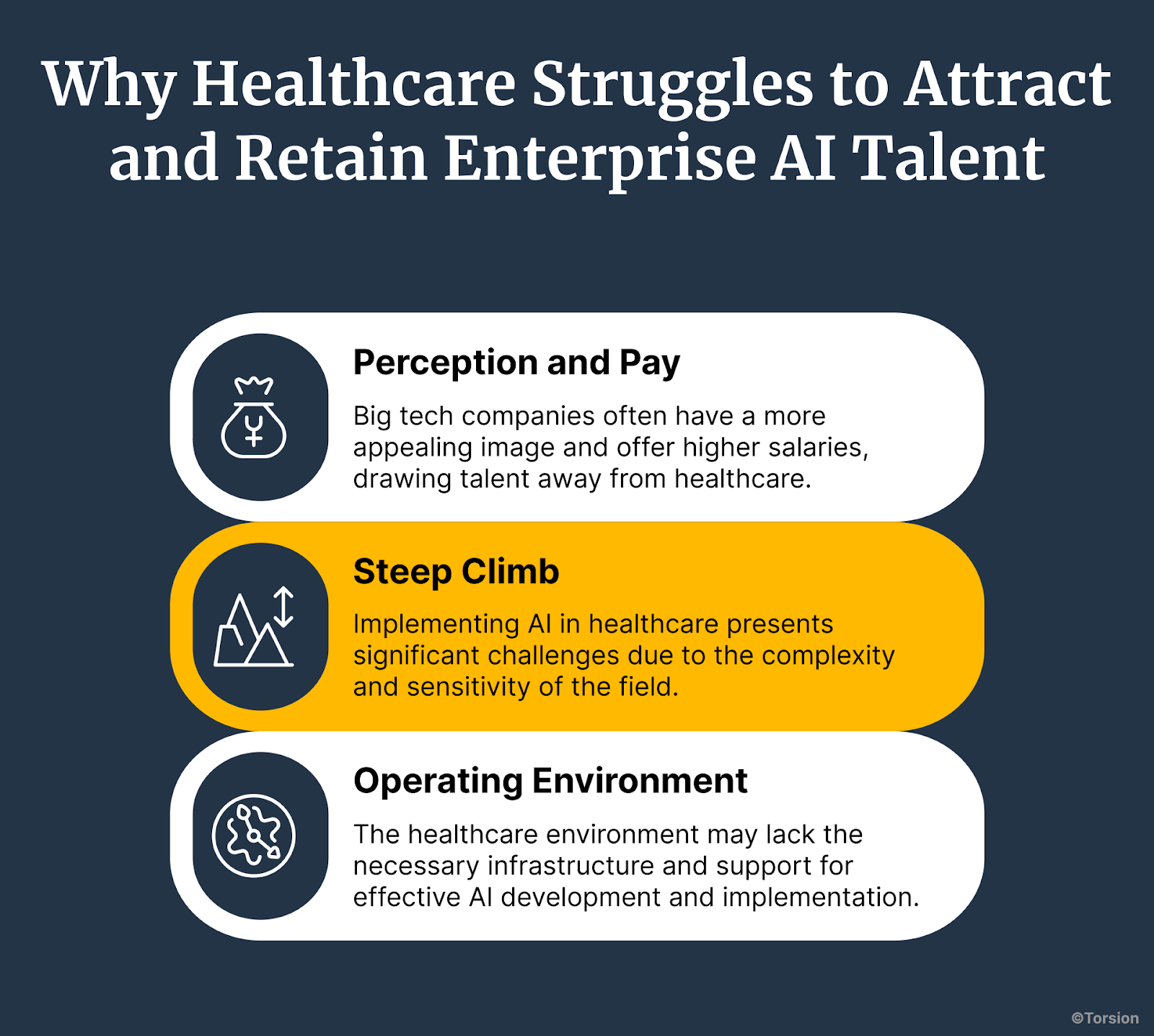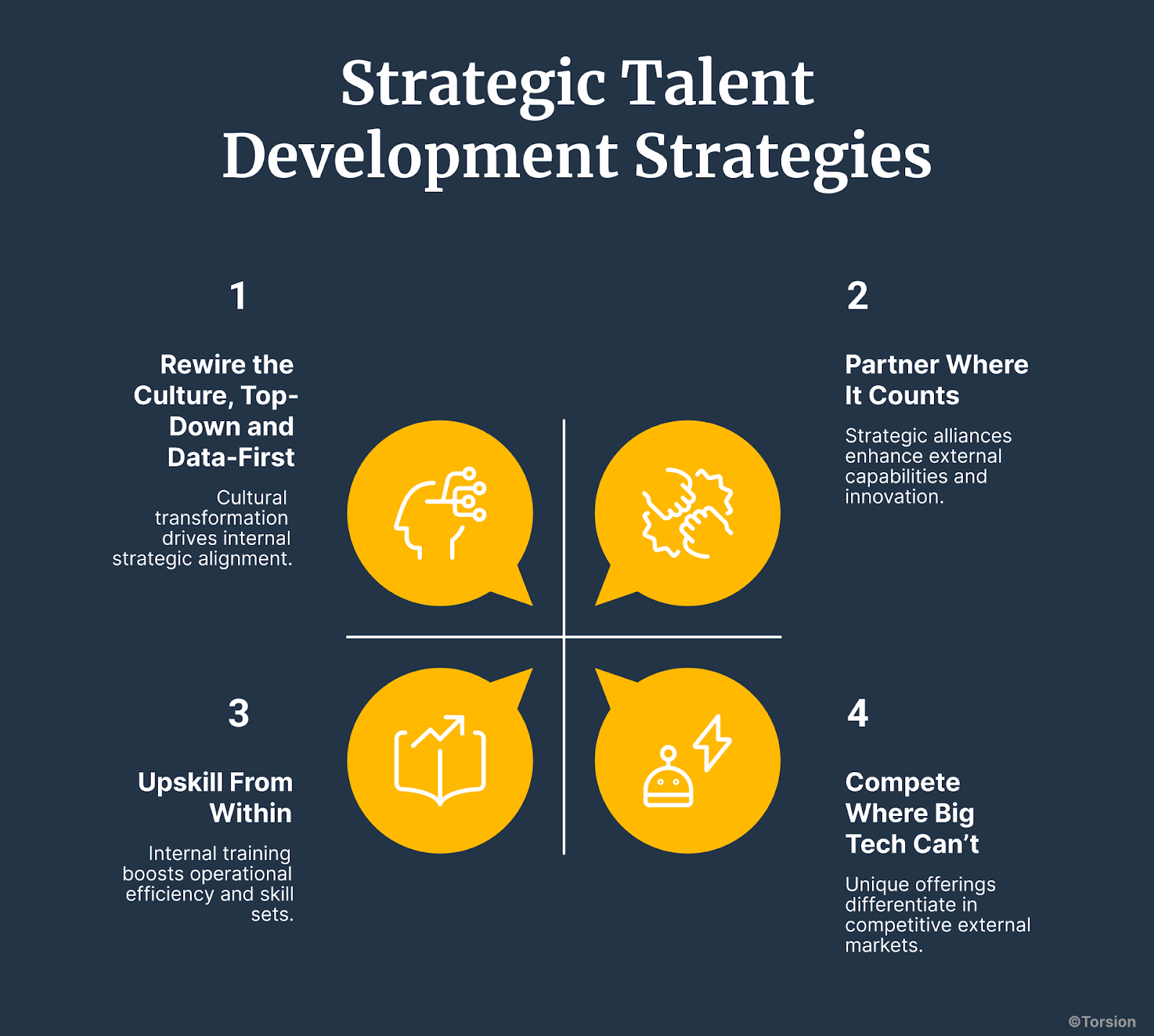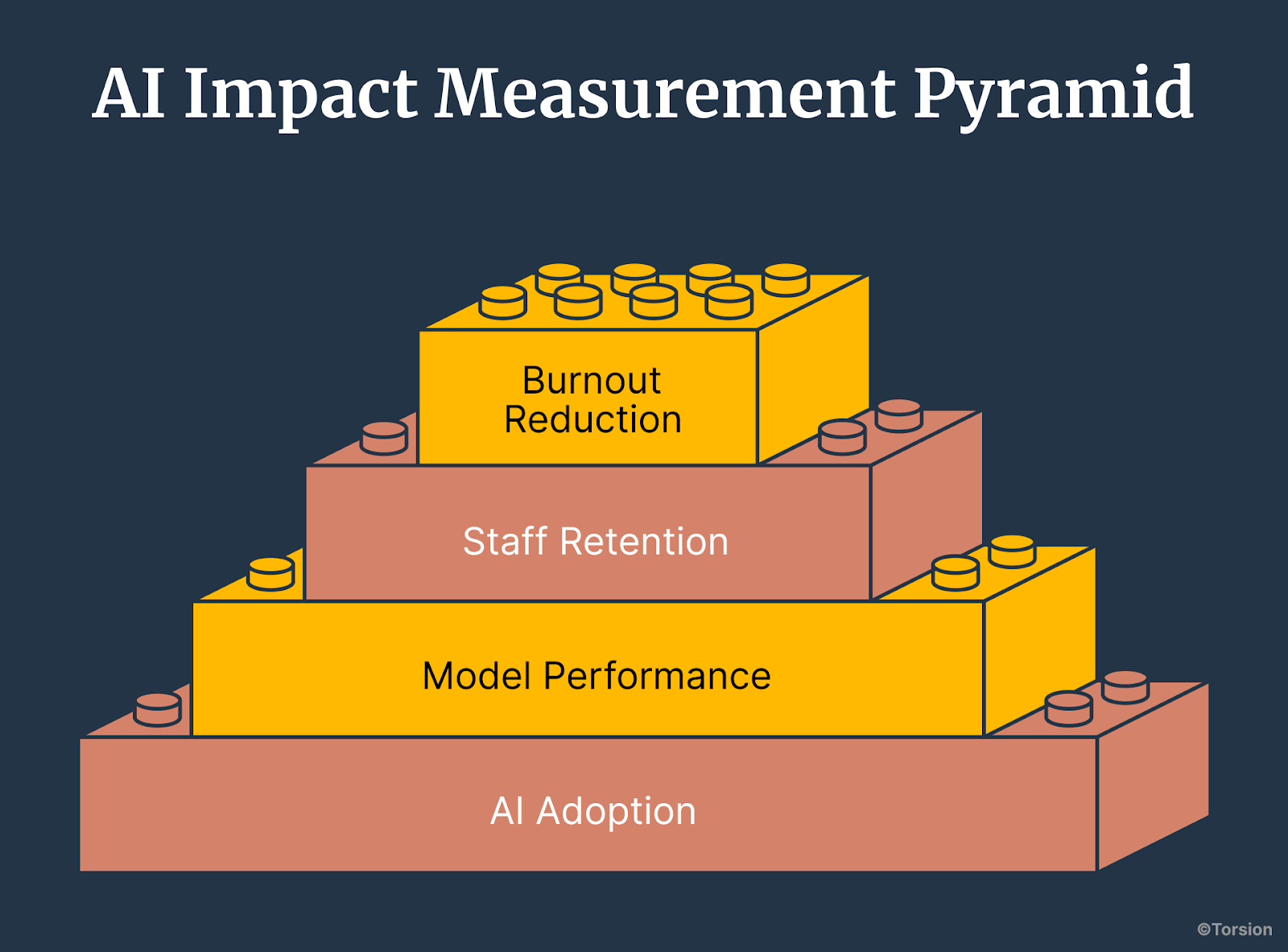Key Takeaways
- 70% of leaders cite talent as the top blocker to enterprise AI adoption.
- The gap is engineers, translators, governance leads, and ethics stewards.
- Big tech still wins on speed, comp, and perception.
- Enterprise AI requires deeper domain knowledge and operational nuance.
- Upskilling, internal fellowships, and industry partnerships drive capability faster than hiring alone.
- Academic partnerships and hybrid curriculums are key to long-term talent pipelines.
Health systems aren’t short on vision. They’re short on the people who can deliver it.
Nearly 70% of healthcare leaders now say the number one barrier to Enterprise AI adoption is often talent, and not funding or infrastructure. Not just engineers, but roles that don’t show up in most job descriptions:
- Clinical translators who bridge data science and bedside care
- Model governance leads who track drift and manage audit trails
- Data strategists who turn messy inputs into usable signal
- Ethical design stewards who flag risks before they scale
Without these people in place, even the best tools stall. Projects remain stuck in proof-of-concept. ROI never materializes. And executive teams start asking why transformation goals feel further away now than they did three quarters ago.
This is basically a structure problem. And health systems weren’t built to attract, or retain, this kind of talent. But that’s what the next section unpacks.
Why Healthcare Struggles to Attract and Retain Enterprise AI Talent
If Eenterprise AI is going to scale in healthcare, the barrier isn’t compute power or infrastructure, it’s people.
Even as global investment in enterprise AI accelerates, crossing $550 billion in 2024, the U.S. is still projected to face a shortfall of nearly 700,000 professionals capable of supporting model-driven systems.
And that’s just on the technical side.
The more critical gap lies in hybrid talent: those who understand both the demands of healthcare operations and the complexity of enterprise-grade data and model governance.
This is a systemic design flaw. And it shows up in three core areas.

A. Big Tech Wins on Perception and Pay
Healthcare simply isn’t winning the talent war.
- Tech firms offer what health systems can’t: equity, scale, and the perception of speed.
- Enterprise AI engineers consistently rank healthcare as 40% slower to innovate than other sectors, especially when it comes to deploying production-grade systems.
- The mission to improve care is powerful, but mission alone doesn’t retain enterprise engineers, especially when competing with hyperscalers.
B. Enterprise AI in Healthcare Is a Steep Climb
Model deployment in healthcare is technically hard and operationally unforgiving.
- Teams must design around HIPAA, FDA guidance, and clinical governance constraints
- The data is fragmented, unstructured, and rarely model-ready
- Errors can impact patient safety, along with performance dashboards
Unlike other sectors, you can’t afford to “move fast and fix later.” That cultural disconnect repels some of the best talent.
C. The Operating Environment Doesn’t Support Enterprise AI Work
Even when healthcare systems manage to hire talent, they struggle to keep it, and to make it effective.
- Analytics maturity is low in many orgs; model teams work in silos without strong clinical alignment
- Operational language is fractured—IT, data, and clinical teams often don’t share a shared mental model
- Trust gaps persist when clinicians aren’t involved in design, they hesitate to adopt what’s built
More than job roles, the main concern is whether health systems have created a home for Enterprise AI talent or just added it to the org chart and hoped for the best.
How to Close the Gap: A Strategic Talent Development Playbook
If Enterprise AI in healthcare is stalling, it’s not because the tech isn’t ready. It’s because the people who can build and run these systems are in short supply and even shorter retention.
The good news: this is fixable. But it takes more than recruiting engineers.
It requires rethinking how healthcare attracts, develops, and supports cross-functional talent who can deliver model-driven transformation at scale.
Here’s the playbook.

A. Compete Where Big Tech Can’t: Mission, Flexibility, Purpose
Health systems can’t match equity packages, but they can lead on meaning.
- Emphasize purpose-driven work: improving patient outcomes, not optimizing clicks
- Offer remote-first roles, flexible schedules, and clear paths to clinical impact
- Use niche recruiters and job boards tailored to Enterprise AI in healthcare
- Deploy model-driven tools for smarter hiring: use data to refine job descriptions and assess candidate fit
Even in a tight market, the right positioning attracts builders who want to solve real problems at human scale.
B. Upskill From Within: Build Literacy Across Roles
The fastest way to close the capability gap is to grow it inside the organization.
- Over 70% of healthcare leaders now recognize Enterprise AI’s potential to transform workforce development
- Launch tailored bootcamps and certification tracks built around clinical workflows, not just generic tech stacks
- Cross-train model engineers in clinical nuance, while giving clinicians fluency in interpreting outputs
- Appoint Enterprise AI Champions in each department to drive alignment and local adoption
This is a culture shift. One that turns end users into strategic contributors.
C. Partner Where It Counts: Don’t Build Alone
You don’t need to staff every role on day one. Strategic partnerships can accelerate lift without long-term bloat.
- Bring in expert consultancies (like Torsion) to stand up proof-of-concept deployments with embedded mentorship
- Design engagements as capability transfer models, not handoffs
- Use the pilot to prove value, then build an internal team to scale the platform
Think beyond deliverables. Build partnerships that evolve into embedded support systems.
D. Rewire the Culture, Top-Down and Data-First
Tools and talent fail fast in environments that aren’t built to support them. Culture is the infrastructure.
- Start with governance: clean, accessible, and secure data is the backbone of scalable Enterprise AI
- Democratize access: equip clinical, operational, and data teams with the right permissions and tools
- Prioritize executive sponsorship: leadership must treat Enterprise AI as core infrastructure, not an innovation side project
Follow the BCG 10-20-70 rule: only 10% of transformation is algorithmic. The other 90% is infrastructure, culture, and people.
Proof in Practice: What Upskilling Looks Like in Action
Strategy is only as good as what it produces. The real test of any Enterprise AI talent plan is what it delivers in adoption, retention, and operational lift.
Across healthcare, the systems seeing momentum are hiring from the outside. They’re also investing internally, forging partnerships, and creating visible career paths for hybrid talent.
Here’s what that looks like on the ground.
Internal Fellowships That Create Embedded Expertise
Programs like the Topol Digital Fellowship in the UK and the CLINAQ Fellowship in the U.S. are helping clinicians become fluent in data science and model validation without pulling them out of care delivery.
- Fellows work on live enterprise AI initiatives, guided by mentors
- Projects result in peer-reviewed outputs and practical toolkits that are shared across clinical teams
- These programs upskill individuals and seed new capability across the system
Fellows become trusted internal advocates who understand both the bedside and the backend.
Cross-Disciplinary Bootcamps for Real Teams
Upskilling is about team-level fluency more than anything else.
Several U.S. health systems have deployed bootcamps that pair nurses with data engineers, or clinical leaders with product teams, to tackle real implementation challenges like embedding model outputs into charting workflows or aligning CDS logic with frontline practice.
The result?
- More usable tooling
- Faster rollout timelines
- Increased adoption because clinicians helped shape the solution
Industry Collaboration That Moves Fast, and Transfers Knowledge
Not every health system can build from scratch. But smart partnerships can bridge the gap.
- Programs like Muse, built by Sanofi, OpenAI, and Formation Bio, show how Enterprise AI can be deployed in under six months from PoC to production
- These collaborations work because they prioritize mentorship, shared ownership, and post-deployment support
The goal is enablement. When external partners help build internal capacity, transformation actually sticks.
How to Measure What Matters
Success is model performance and system performance combined.
The health systems leading the way in talent development measure impact with metrics that go beyond accuracy scores:
- Enterprise AI adoption rates across departments
- Model performance in production, not just testing
- Staff retention in newly created data + clinical hybrid roles
- Burnout reduction where automation has taken real load off the floor
When you upskill the right way, you train people and rewire the system to support them.

Universities and Industry: Building the Long-Term Pipeline
Not every health system can solve the talent gap with hiring and training alone. Long-term success depends on something deeper: shaping the ecosystem that feeds the next generation of Enterprise AI talent.
Short-term fixes are important. But unless academic institutions and healthcare organizations align on what the future of Enterprise AI work looks like, the pipeline stays narrow and the pace of innovation stays stuck.
Here’s what forward-looking systems are already doing.
Academic Partnerships That Go Beyond Internships
Leading health systems are collaborating directly with data science programs and teaching hospitals to run joint R&D initiatives that solve real operational problems, not just academic ones.
- Some organizations are embedding Enterprise AI use cases into capstone projects
- Others are co-hosting rotational fellowships where students cycle through engineering, governance, and clinical implementation teams
Curriculum Co-Development with a Clinical Lens
The skills gap is technical, but mainly structural. That’s why the most effective partnerships are building hybrid coursework that blends:
- Machine learning
- Medical ethics and equity
- Health policy
- Model governance and regulatory awareness
One standout example: NHS-affiliated programs in the UK now offer modules that train students not just on how models work but how they fit into systems with high accountability and complex workflows.
Medical schools, nursing programs, and MPH tracks need to evolve, too. Enterprise AI literacy should be a baseline competency, not a specialist track.
Early-Career Programs That Seed Purpose-Driven Careers
Rotational fellowships and applied internships are part of how the next generation decides whether to stay in healthcare at all.
- Programs like CLINAQ pair clinicians with technical mentors to develop publishable AI-driven research
- Participants aren’t expected to be technical experts, but they’re trained to spot where model-driven workflows can actually help
- These programs reinforce what many early-career professionals are looking for: work with real-world impact, not just theoretical applications
Healthcare has a shot at positioning itself as the most meaningful place to build a career in Enterprise AI. But only if that meaning shows up early and often.





